Have you heard the story about a boy born in Yorkshire, England, who studies art in Birmingham, finds his way to Finland to work with design maestro Alvar Aalto, and then crafts a printer that Steve Jobs loved?
I have, at CES 2019, when I sat down with Sean Carney, Chief Designer at Philips.
It’s well-known that Philips has been firmly focused on health and health care, covering both clinical/professional healthcare as well as personal health for self-care. What you may not know is that underpinning the company’s innovations is a major commitment to all aspects of design. Design is embedded in Philips, which is one of first companies to bring design into a company in this way.
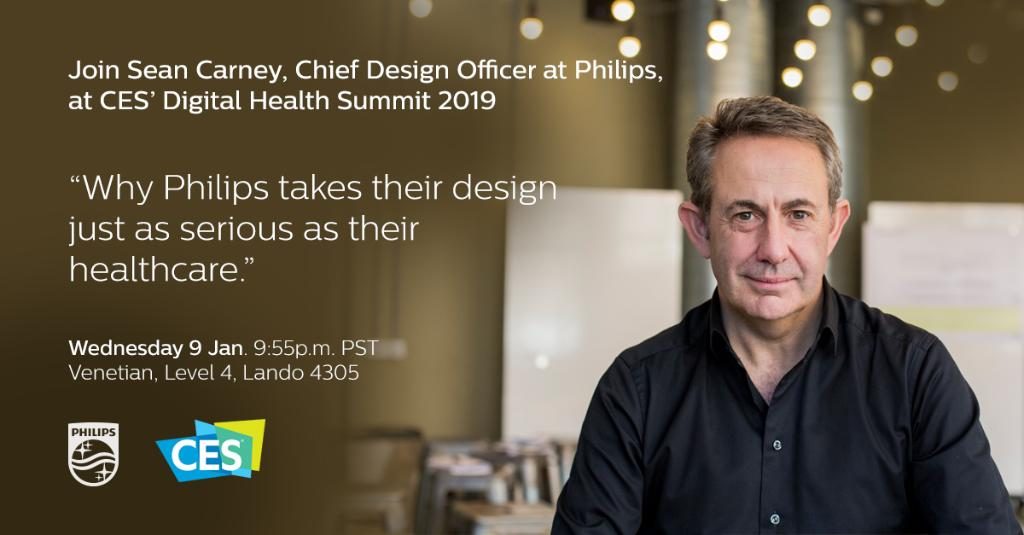 The person who leads that macro design ethos and workflows at Philips is Sean Carney. He’s part of Philips’ leadership team, and as such design informs corporate strategy at the company.
The person who leads that macro design ethos and workflows at Philips is Sean Carney. He’s part of Philips’ leadership team, and as such design informs corporate strategy at the company.
I was grateful to Sean for spending time with me at CES 2019 in Las Vegas to brainstorm the role of design in health/care.
Sean wears two hats at Philips: as Chief Design Officer, he manages the entire design team and workflow globally. But he dons a second hat, too, as General Manager of Healthcare Transformation Services, Philips’ consulting services for healthcare providers. Launched in 2013, the team now has about 150 health care consultants, spanning Chief Nursing Officers, Chief Marketing Officers, ex-department heads of hospitals — the range of professionals who can, as Sean said, “dig in and redesign care pathways that optimize performance through design.”
Consider Philips’ core business in the clinical tech supply side: the team works on the “micro level from the device” to the clinical workflow, Sean explained to me. Imagine Cath labs, rooms where doctors navigate inside a heart, using software and guidance systems, x-rays and ultrasound tools at the ready. The consulting team assesses both patient experience and care pathways, beyond a medical device company’s traditional role of selling medical devices to health care providers.
To give you an example of this process, here’s one of my favorite examples of Philips’ design-ful approach in a health care setting. This video of “Dutch Masters” illustrates a collaboration to re-imagine a patient’s MRI experience in concert (literally) with the Rotterdam Philharmonic Orchestra, the Rijksmuseum (Amsterdam’s brilliant art collection), the Erasmus Medical Center, and AMC Amsterdam (not the cinema company but the Dutch academic medical center). I ask you to invest just two minutes to see this to get a sense of how design thinking can re-make patient and clinician experience.
Sean pulls this design thinking approach through the continuum of care that the Philip’s serves: from self-care at home through the company’s consumer health products into the hospital, to rehabilitation, and recovery back at home. Beyond one patient’s home, think about the larger community of many homes: Philips is involved with a Florida hospital group and a property developer conceiving a master plan of a city. So that brings Philips into the larger ecosystem of the healthy city which can be informed through data generated in smart, connected homes (see my post covering one wellness home concept here in Health Populi). One of the underlying concepts for this city will be the Blue Zones, to ensure active transportation, healthy food access, and wellness baked into the various touch points of city planning.
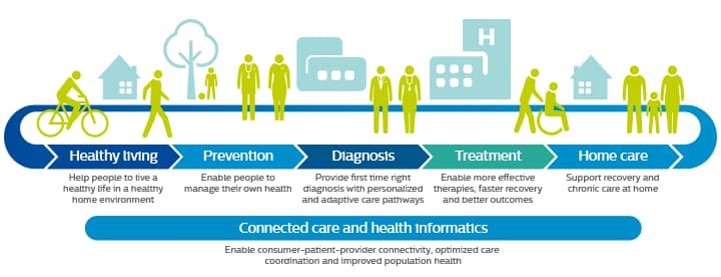 “We have designers embedded in each business unit from consumer health through clinical medical technology products,” Sean explained. “At Philips, designers work horizontally across business units, not in isolation; they’re connecting dots, patient journeys, and multiple points,” Sean said.
“We have designers embedded in each business unit from consumer health through clinical medical technology products,” Sean explained. “At Philips, designers work horizontally across business units, not in isolation; they’re connecting dots, patient journeys, and multiple points,” Sean said.
He continued: “As designers, we cannot just design the beautiful object anymore. Now we need to think about the wider ecosystem.”
Understanding that ecosystem, Philips is partnering with many organizations to innovate better solutions for health care providers and consumers. For example, Philips Mother and Child Care group recently allied with BabyScripts to bolster the company’s portfolio of services to help women manage prenatal care to improve outcomes and boost empowerment throughout pregnancy. At CES 2019, Philips announced a new teledentistry service, connected to the Sonicare oral health business, where toothbrush users could connect virtually with dentists via the Sonicare app. For this service, Philips is collaborating with the Toothpic dental network.
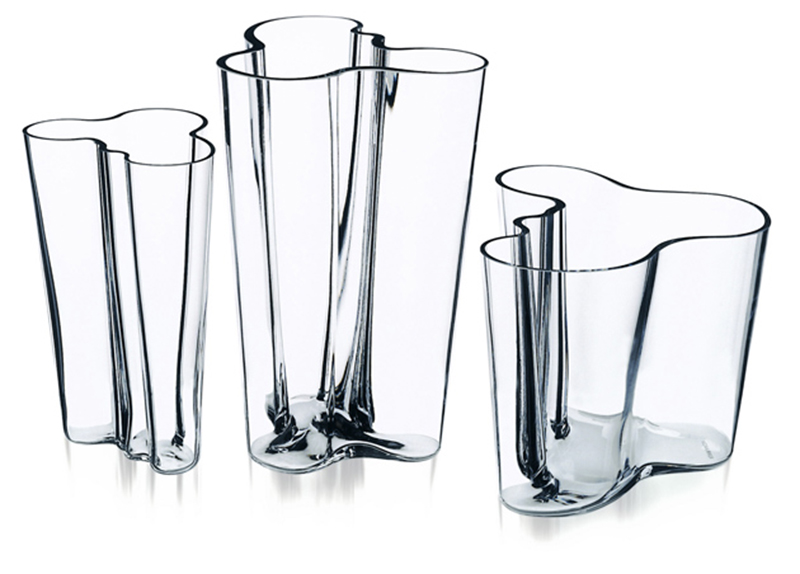 As I learned more about Sean’s career path and design journey, this assertion made sense and brought me full circle from his early career to his global design role at Philips today, in Amsterdam and around the world.
As I learned more about Sean’s career path and design journey, this assertion made sense and brought me full circle from his early career to his global design role at Philips today, in Amsterdam and around the world.
Sean grew up in Teesside in Yorkshire, in northeastern England. He attended art school in Birmingham, and then worked in Europe as a product designer. I asked him who were his early design influencers, and was surprised and delighted to hear the name of Alvar Aalto. You may know of Aalto through the image here, the iconic Savoy vase that’s exhibited in the Museum of Modern Art. Sean also learned from Kaj Franck, another Scandinavian designer with a mission to imbue luxury into everyday objects, counter to the growing throwaway mentality we are now working to reverse in the developed world.
Thus was the lesson of quality and sustainability part of Sean’s design journey.
He was eventually lured to southern California, to join HP (Hewlett-Packard). There, Sean brought the ethos of quality to his design work in drawing up beautiful ideas for printers. But at that time and marketplace, HP management wasn’t looking for enchanting design: they were looking to sell more ink.
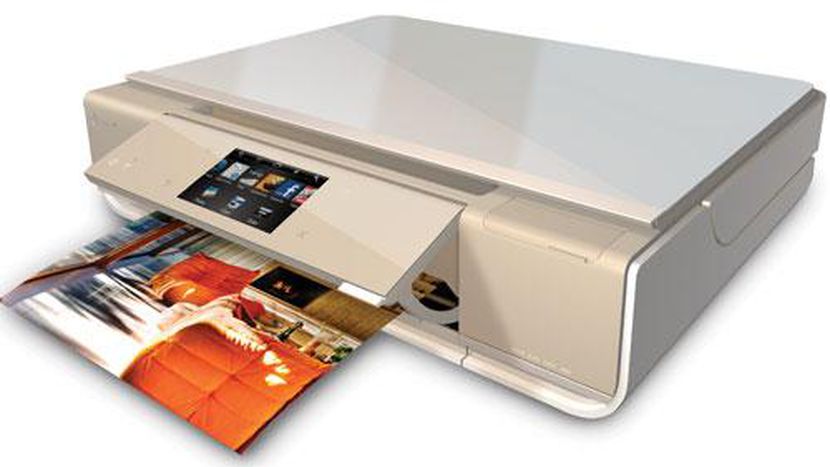 An influential customer then challenged Sean’s team to make the objective beautiful and functional. That demanding client’s name was Steve Jobs, head of Apple.
An influential customer then challenged Sean’s team to make the objective beautiful and functional. That demanding client’s name was Steve Jobs, head of Apple.
This was a wake-up call for Sean’s team. The short story is that Jobs was looking for a beautifully-designed printer (consistent with Apple’s Chief Designer Officer Jonny Ive’s sensibility) that could play in the Apple ecosystem. So Sean and team went back to the drawing board and created the AirPrint printer. It was made of glass and aluminum, and incorporated a little “theatre” into the process — as the printed document exited the printer, a front flap “lifted” to eject the page.
Jobs loved it – the functionality, the sleek design, and the theatrical output.
That’s when Sean thought more about service design beyond a product’s look and feel. It was also about the larger ecosystem in which the product functioned (e.g., HP’s printer working with Apple’s OS), devices and people playing well together in their collective sandbox (HP vs. Apple culture), and streamlining life- and work-flows for the people using the products.
Sean was later recruited by Philips to infuse his growing service design sensibility into the company as it doubled down on health and the larger health/care ecosystem. Carney’s design thinking translated into the Philips culture relatively quickly, as their 39 design awards garnered in 2013 from the prestigious iF competition attests; that story, here.
You can hear directly from Sean via this interview recorded at CES 2019 following his talk at the Digital Health Summit:
Health Populi’s Hot Points: As health care systems must seek more sustainable ways to deliver services, the concept of “value” is pervading government and private sector payors around the globe.
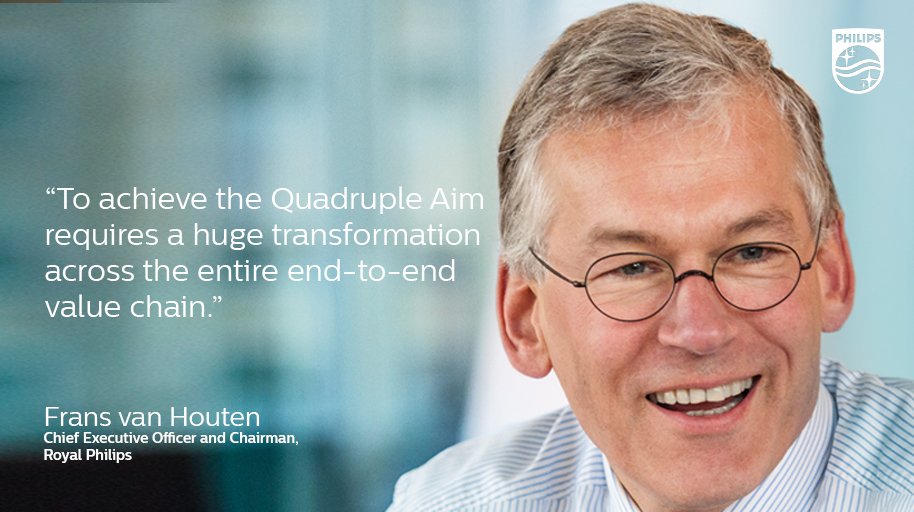 The Quadruple Aim has become an operational beacon for health systems: that is,
The Quadruple Aim has become an operational beacon for health systems: that is,
- To enhance health care outcomes
- To enchant the process of care
- To ensure clinicians stay healthy and don’t burn out, and
- To lower per capita costs.
To accomplish such an audacious goal, one element must be added: that is the self-care and engagement of patients and consumers in their own health. This, then, requires respect for that individual. A seminal article in JAMA from October 2015 was a lightbulb moment for my thinking on this — titled, Value-Based Payment Requires Valuing What Matters to Patients.
We turn to design professionals who have the skills to unearth the knowledge of what patients, caregivers and providers feel and think about health, care, and life-flows. Philips has embraced this mission through the vision and diligence of Sean Carney and the large team of designers working with Philips around the world.


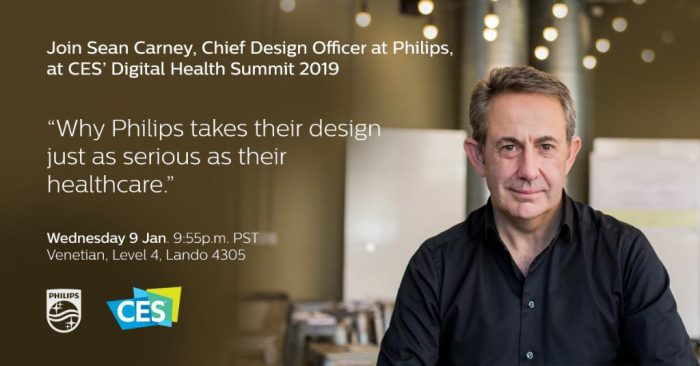


 I'm in amazing company here with other #digitalhealth innovators, thinkers and doers. Thank you to Cristian Cortez Fernandez and Zallud for this recognition; I'm grateful.
I'm in amazing company here with other #digitalhealth innovators, thinkers and doers. Thank you to Cristian Cortez Fernandez and Zallud for this recognition; I'm grateful. Jane was named as a member of the AHIP 2024 Advisory Board, joining some valued colleagues to prepare for the challenges and opportunities facing health plans, systems, and other industry stakeholders.
Jane was named as a member of the AHIP 2024 Advisory Board, joining some valued colleagues to prepare for the challenges and opportunities facing health plans, systems, and other industry stakeholders.  Join Jane at AHIP's annual meeting in Las Vegas: I'll be speaking, moderating a panel, and providing thought leadership on health consumers and bolstering equity, empowerment, and self-care.
Join Jane at AHIP's annual meeting in Las Vegas: I'll be speaking, moderating a panel, and providing thought leadership on health consumers and bolstering equity, empowerment, and self-care.